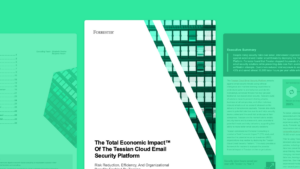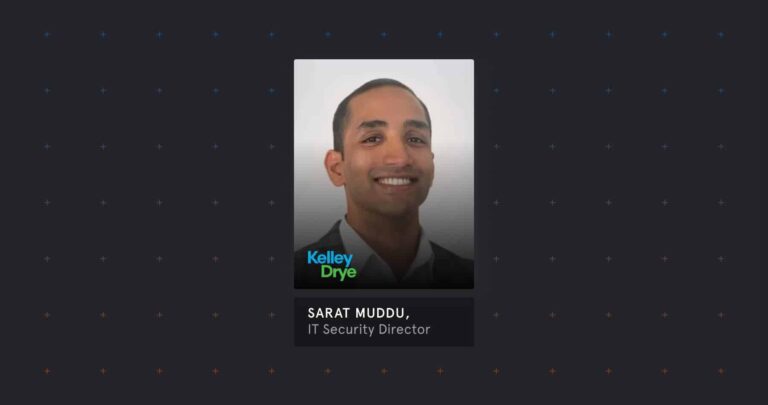As cyber risk continues to escalate, strategic collaboration between the Chief Information Security Officer (CISO) and Chief Financial Officer (CFO) is becoming more important.
In a recent webinar discussion between Tessian’s CFO, Daniel Kim, Jason Thomas, CIO at Cole, Scott and Kissane and Steve Kinman, CISO at Snyk, we talked about the key elements to addressing cyber risk at a strategic and fundamental level.
What did we uncover? Ultimately, the CISO and CFO roles are changing, and collaboration between these two important stakeholders is essential for businesses to mitigate cyber risk, while also driving business objectives forward. The panel also outlined some of the key principles necessary for enabling a dynamic risk mitigation and business value-led partnership.
1. Focusing on cybersecurity fundamentals
The risk for a cyber breach and the costs associated with breaches are increasing. In fact, the 2022 Cost of a Data Breach Report from IBM revealed that the cost of a data breach now stands at $4.35 million, up 13% from 2020.
According to Jason Thomas, CIO at Cole, Scott and Kissane, security leaders must focus on the security fundamentals as a starting point. This includes understanding your environment i.e. classifying your assets, knowing what you have from a technology and people standpoint, as well as the degree of cyber risk faced by your organization.
2. Quantifying cyber risk
For Daniel Kim, CFO at Tessian, moving away from a binary quantification of cyber risk is the first and important step to addressing increasing cyber risk, so too is appreciating that “the risk is never going to be zero.”
As a next step, he says, it is important that companies also appoint C-suite steering committees that should operate in a similar fashion to disaster risk committees. This would move companies out of a reactive to a proactive position on cyber risk mitigation.
3. Prioritize cybersecurity spending
Prioritizing cybersecurity investments can often face questions of relevance from other business leaders on the value that these investments would add to the company. For Jason it is essential that company leaders ask themselves, “how much is one hour of downtime worth to the company.”
For Steve Kinman, CISO at Snyk, many companies are still struggling to adequately prioritize cybersecurity program development, stating “what I hear a lot from teams is that they’re doing a lot of ad hoc security planning…and there’s no-rollup of that information to the C-suite or board.” Every cybersecurity initiative, he says, must be aligned with the business and its objectives.
4. Cyber risk as a financial risk
On the growing importance of CFO and CISO relationship building, Tessian’s Dan underscores that the growing importance rests on two important aspects, namely the frequency and the impact of risk.
On frequency of risk, it is imperative that leaders understand what risks exist in their environment. This can range from natural, geopolitical, financial and cyber risk. On impact, the increasing costs associated with cybersecurity events, including loss of revenue, downtime, to the loss of data and IP, have rendered cyber risk as a financial risk, says Dan.
Combined with regulatory changes that will result in the C-suite being held personally liable for cyber breaches is essentially elevating the importance of dealing adequately with cybersecurity risk – with Dan adding, “reacting to a breach after the fact is no longer a good business model.”
5. Healthcheck on the CISO and CFO relationship
Synk’s CISO Steve noted that for the majority of organizations a disconnect between the CISO and CFO is apparent, noting many CFOs don’t understand cybersecurity terminology and do not understand the real cyber risk facing their organizations. It’s important to shift the conversation from cyber risk to business risk.
Touching on the evolution of the CISO role, Jason states it is critical that security leaders understand the fundamental financial aspects of the business in order to prioritize investments to address these risks.
6. The importance of ROI
Having measurable return on investment (ROI) from your security tools is non-negotiable for every business. For Jason, this entails conducting routine audits on the security tool efficacy. Not being able to get the data out of the tools and demonstrate what impact they are having leaves you unable to determine whether the tool is performing as expected and is delivering ROI.
Using a framework that categorizes the investment by the following criteria for Dan is helpful:
- investments that generate revenue
- investments that cut cost
- investments that manage risk
Every business leader – including CISOs – need to be able to translate their area of expertise and programs underway to business outcomes, according to Dan. Learning how to speak the same risk language, being the catalyst for change and making it a collaborative journey is so important to achieving business outcome success.
7. Become an effective C-suite communicator
It’s only once a breach has happened that cybersecurity programs are prioritized. This, according to Steve, is the well-known mantra of “not wasting a breach” to increase the cybersecurity budget.
Although this approach is commonly used in the industry, there is a need for a more proactive approach. Steve cautions, however, that security and risk leaders need to be tactical with their asks for additional cybersecurity investments – you need to have a well developed and well-communicated cybersecurity strategy in place first.
Additionally, overcoming communication obstacles that may exist between the CISO and the C-suite, requires developing a set of metrics for reporting that conveys maturity of the program, rollout according to timeframes, and being able to show how risk is trending. The C-suite and board require a different type of language than most security practitioners are familiar with – don’t go too deep on security jargon.
8. Overcoming the cybersecurity perception problem
In a 2022 Tessian study, we found that only 58% of employees believe that senior executives at their company value cybersecurity. For Steve, recognizing that most companies recognize that cyber risk is the number 1 risk, and that’s where the acknowledgement stops.
Even large corporations don’t demonstrate how essential cybersecurity and cyber risk mitigation are to their overall growth strategies. Cyber risk needs to be intertwined in the business plan and commonly understood by all of the business units. When cybersecurity risk is not referenced in the business plan that is where the perception of cybersecurity not being valued manifests from.
Jason and Dan agree that security awareness training needs to be ongoing and doesn’t need to be overly complex. Jason uses a constant messaging approach to drive security awareness on the risks being seen in the industry and measures his team have in place to safeguard his company.
Building a Long-Term Relationship
The importance of strategic collaboration between CFOs and CISOs is coming into sharper focus, particularly as cyber risk continues its upward trajectory.
For organizations that are behind the technology adoption curve, according to Dan, cybersecurity risk can no longer be seen as a standalone, siloed IT project, but rather it needs to be seen as key business risk facing the enterprise.
Sharing information and intelligence i.e. constant communication on breaches threat trends in the industry as well as demonstrating what measures are in place helps Jason and his team build trust with the C-Suite.
Steve advises, it can be very intimidating to think that the CFO doesn’t care about cyber risk, get over that fear, go and speak to your CFO, build that relationship.
Building an effective relationship between the CFO and CISOs takes collective effort, as well as a shared view on the extent of cyber risk facing the organization. Having a well-oiled partnership between these two important business stakeholders can both mitigate cyber risk and as well as deliver success on business objectives.
To see how Tessian prevents ransomware attacks, and protects against DLP, watch a product overview video or book a demo.
For the latest cybersecurity news and articles, sign up for our newsletter, and follow us on Twitter and LinkedIn


















